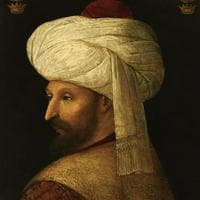Mehmed the Conqueror mbtiパーソナリティタイプ
個性
"Mehmed the Conquerorはどのような性格タイプですか? Mehmed the Conquerorは、INTJ in MBTI、1w9 - so/sp - 153 in Enneagram、SCOEI in Big 5、LSI in socionics のパーソナリティタイプです。"
his last words: Behold, I am dying, but I am not sorry that I am leaving behind like you. Be just, righteous, and merciful, and extend your protection to the parish without discrimination, and work to spread the Islamic religion, for this is the duty of the kings on earth. Give attention to the matter of religion over everything, and do not be diligent with perseverance on it, and do not use people who do not care about the matter of religion, do not avoid major sins and indulge in immorality, the aspect of corrupting heresies, and keep those who incite you to it. Expand the area of the country through jihad, and protect the treasury funds from being wasted. Never reach out to the money of someone from your parish except for the right of Islam, and guarantee their strength for the needy, and pay your honor to those who are worthy. And since the scholars are like the power installed in the body of the state, so glorify their side and encourage them, and if you heard about any of them in another country, bring him to you and honor him with money. Beware, beware, do not be tempted by money or soldiers, and beware of keeping the people of the Sharia away from your door, and beware of leaning towards any action that contradicts the provisions of the Sharia, for religion is our goal, guidance is our approach, and thus we are victorious. Take this lesson from me: I attended this country as a little ant, and God Almighty gave me these majestic blessings. Causes of perdition.
バイオグラフィー
Mehmed II (30 March 1432 – 3 May 1481), commonly known as Mehmed the Conqueror, was an Ottoman Sultan who ruled from August 1444 to September 1446, and then later from February 1451 to May 1481. In Mehmed II's first reign, he defeated the crusade led by John Hunyadi after the Hungarian incursions into his country broke the conditions of the truce Peace of Szeged. When Mehmed II ascended the throne again in 1451 he strengthened the Ottoman navy and made preparations to attack Constantinople, which he conquered in 1453. At the age of 21, he conqueredConstantinople (modern-day Istanbul) and brought an end to the Byzantine Empire. After the conquest Mehmed claimed the title "Caesar" of the Roman Empire (Qayser-i Rûm), based on the fact that Constantinople had been the seat and capital of the surviving Eastern Roman Empire since its consecration in 330 AD by Emperor Constantine I. Mehmed continued his conquests in Anatolia with its reunification and in Southeast Europe as far west as Bosnia. At home he made many political and social reforms, encouraged the arts and sciences, and by the end of his reign, his rebuilding program had changed the city into a thriving imperial capital. He is considered a hero in modern-day Turkey and parts of the wider Muslim world. Mehmed II is recognized as the first sultan to codify criminal and constitutional law, long before Suleiman the Magnificent; he thus established the classical image of the autocratic Ottoman sultan. Mehmed's thirty-one year rule and numerous wars expanded the Ottoman Empire to include Constantinople, the Turkish kingdoms and territories of Asia Minor, Bosnia, Serbia, and Albania. Mehmed left behind an imposing reputation in both the Islamic and Christian worlds.















